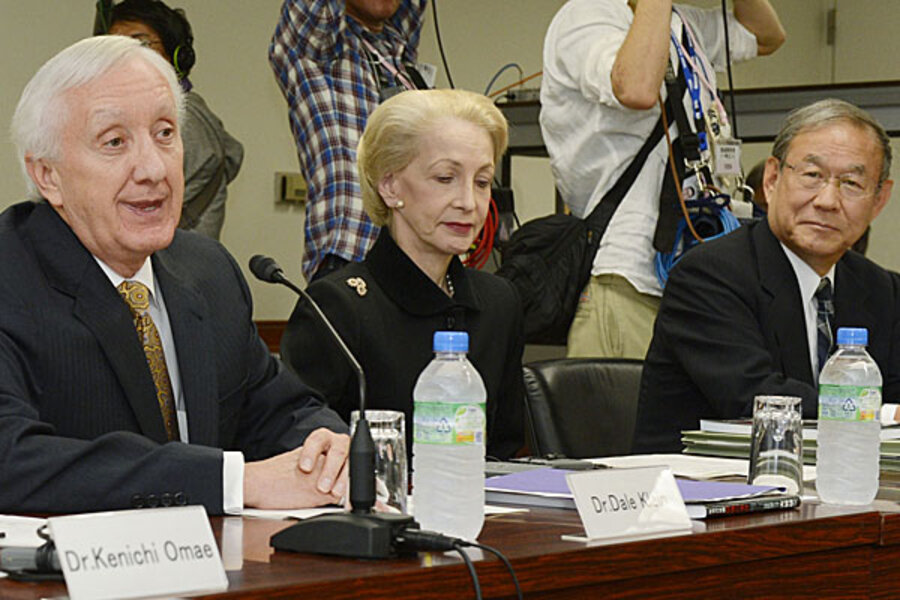Why Tokyo Electric Power didn't act on safety issues before tsunami
Loading...
| Tokyo
The utility behind Japan's nuclear disaster acknowledged for the first time Friday that it could have avoided the crisis.
Tokyo Electric Power Co. said in a statement that it had known safety improvements were needed before last year's tsunami triggered three meltdowns, but it had feared the political, economic and legal consequences of implementing them.
"When looking back on the accident, the problem was that preparations were not made in advance," TEPCO's internal reform task force, led by company President Naomi Hirose, said in the statement. "Could necessary measures have been taken with previous tsunami evaluations? It was possible to take action" by adopting more extensive safety measures, the task force said.
RECOMMENDED: Obama vs. Romney: 7 ways they differ on energy
The task force said TEPCO had feared efforts to better protect nuclear facilities from severe accidents such as tsunamis would trigger anti-nuclear sentiment, interfere with operations or increase litigation risks. TEPCO could have mitigated the impact of the accident if it had diversified power and cooling systems by paying closer attention to international standards and recommendations, the statement said. TEPCO also should have trained employees with practical crisis management skills rather than conduct obligatory drills as a formality, it said.
The admissions mark a major reversal for the utility, which had defended its preparedness and crisis management since the March 2011 tsunami. The disaster knocked out power to the Fukushima Dai-ichi nuclear plant, leading to the meltdowns, which forced massive evacuations and will take decades to clean up.
The statement was released after TEPCO held its first internal reform committee meeting, led by former U.S. nuclear regulatory chief Dale Klein. His five-member committee oversees the task force's reform plans.
"It's very important for TEPCO to recognize the needs to reform and the committee is very anxious to facilitate the reform necessary for TEPCO to become a world-class company," Klein told a news conference. "The committee's goal is to ensure that TEPCO develops practices and procedures so an accident like this will never happen again."
The reform plans aim to use the lessons learned at TEPCO's Kashiwazaki-Kariwa plant in northern Japan. The cash-strapped utility wants to restart that plant, but TEPCO officials denied the reform plans are aimed at improving public image to gain support for the plant's resumption.
"The reforms are intended to improve our safety culture, and we have no intention to link it to a possibility of resuming the (Kashiwazaki-Kariwa) plant," said Takafumi Anegawa, the TEPCO official in charge of nuclear asset management. "We don't have any preconditions for our reforms."
The Fukushima Dai-ichi plant has been substantially stabilized but is still running on makeshift equipment as workers continue their work to decommission the four damaged reactors, which could take several decades.
Additional safety measures have been installed at nuclear power plants nationwide since the accident under the government's instructions, including enhancing seawalls, adding backup power and cooling water sources, and developing better crisis management training. But plant operators will be required to take further steps as a new nuclear regulatory authority launched in September steps up safety requirements.
Investigative reports compiled by the government and the parliament panels said collusion between the company and government regulators allowed lax supervision and allowed TEPCO to continue lagging behind in safety steps.
Despite records indicating a major tsunami had once hit off Japan's northern coast, TEPCO took the most optimistic view of the risk and insisted that its 5.7-meter-high seawall was good enough. The tsunami that struck Fukushima Dai-ichi was more than twice that height.
The company had said in its own accident probe report in June that the tsunami could not be anticipated and that the company did the best it could to bring the critically damaged plant under control, although there were shortfalls that they had to review. TEPCO bitterly criticized what it said was excessive interference from the government and the prime minister's office.
TEPCO's Anegawa said the task force plans to compile by the end of the year recommendations "that would have saved us from the accident if we turn the clock back."
RECOMMENDED: Obama vs. Romney: 7 ways they differ on energy
Copyright 2012 The Associated Press.





